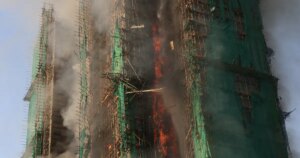
The facade of the Santa Isabel hospital in Cartagena, which burned down this Wednesday without causing any casualties, is covered with highly flammable panels: aluminum sheets filled with polyethylene, a material that acts like “solid petrol” in contact with the flames and is present in other buildings devastated by exceptional fires in recent years. These include the Campanar block, in Valencia, where 10 people died in 2025; the Torre dei Moro, in Milan, destroyed in 2021; the Torre Ámbar in Madrid, which burned in 2020; or the Grenfell Tower in London, whose fire in 2017 caused 72 deaths and triggered international alarm over this material. The same hospital in Cartagena had already suffered a fire in 2015, also without injuries.
The panels that cover the hospital in Cartagena, the building in Valencia or the apartment towers in Madrid and Milan were produced by the same company, the Spanish Alucoil. Two of its directors are accused in an Italian court of marketing these facade coatings, called Larson PE.
Although the danger of the material is known, in Spain there is no census of buildings with combustible facades. Changes were announced after the Campanar tragedy, but no community made specific data public. It is known, thanks to an analysis by the CSIC, that in Spain there are at least fourteen buildings that use this type of panels, from condominiums to shopping centers. The Santa Lucía Hospital in Cartagena is among these.
This center, in fact, already burned in 2015, even before the Grenfell Tower in London. After the accident in Valencia, the Podemos deputy of the Murcia Region María Marín drew attention to the material on the roof of the Santa Lucía Hospital and asked for its replacement, recalling how in 2015 a fire consumed part of the facade of block one of this health center due to a badly extinguished cigarette butt. On that occasion, the roofing material was blamed from the start as responsible for the rapid spread, even though little was done to prevent future problems like the one that occurred last Wednesday.
A year after the deputy had asked to renovate the facade of the hospital and the appearance of the Murcian Minister of Health, Juan José Pedreño, the party managed to advance a motion in the Regional Assembly for the government to intervene in the matter, but everything remained there. “It’s not an accident,” Marín said after Wednesday night’s incident. “Today what they knew perfectly well could burn has burned again. And that has a name: political negligence,” he said. “When a government puts savings before public safety, it means accepting that an entire hospital is exposed to a fire like the one this morning.”
A highway of fire
Larson PE panels are now out of production, but they have been on the market since 2001 and for years they were used under the cover of the fire regulations in force at the time, starting from 1990. Thus, when the licenses were granted for buildings such as Campanar, in Valencia, or the Torre Ámbar in Madrid, in 2005 and 2006, the entry into force of the European update on the fire resistance of building materials, which prevents the use of these panels in facades.
These coatings accumulate several unfavorable reports from the Eduardo Torroja Institute of Construction Sciences (IETcc), dependent on the CSIC. Already in 2008 the center had warned that the panels were not fireproof, but their use continued for years.
Each panel is a sandwich made of 0.5 millimeters of aluminium, three millimeters of polyethylene and another final layer of 0.5 millimeters of aluminium. They are installed on ventilated facades, a system that leaves an air chamber between the internal wall and the cladding. This construction model became popular at the beginning of the century because it improved the thermal insulation and comfort of homes.
However, in the event of a fire, this cavity acts as a “fire highway”. When the flames reach the panels, the layers quickly melt; The highly combustible polyethylene begins to drip, and the internal chamber acts as a chimney that triggers the speed and voracity of the flames.
Spain is in last place in Europe when it comes to regulations against domestic fires, as highlighted to this newspaper by the Observatory of New Fire Risks, a body created in June last year which brings together 19 private sector organisations. In 2006 and 2019 the rules, contained in the technical building regulations, were tightened, but they did not go so far as to exclude the use of combustible materials. In fact, polyethylene is also used combined with additives that slow down the expansion of flames, warned the president of the observatory, Andrés Pedreira.
So far, little is known about the inventories of dangerous buildings that several Autonomous Communities promised after the events in Valencia. We only know that that of the Generalitat Valenciana is 25 properties built between 2020 and 2024 have been identified “in which a more in-depth analysis of their facades may be appropriate”; In the Community of Madrid, according to the Official College of Architects, dangerous buildings have been registered, but the regional government did not want to disclose the exact number; and in Catalonia the study is not yet finished, even if the announced deadline has already expired.
This is a very different approach to that of the UK, where after the Grenfell fire the authorities began a mapping and removal process. THE latest published dataupdated month by month, they indicate that 5,011 residential buildings with dangerous cladding have been detected. Of these, 2,403, almost half, had started or completed renovation works thanks to a public aid program.
Even in Spain the judicial process has not prospered. The Campanar case failed before the Valencia court, which ultimately closed it because it was considered an accident. However, the events of the Torre dei Moro in Italy are currently under trial. Two Alucoil employees are accused of being sellers of these panels in Italy, accused of participating in a crime of negligent catastrophe.




